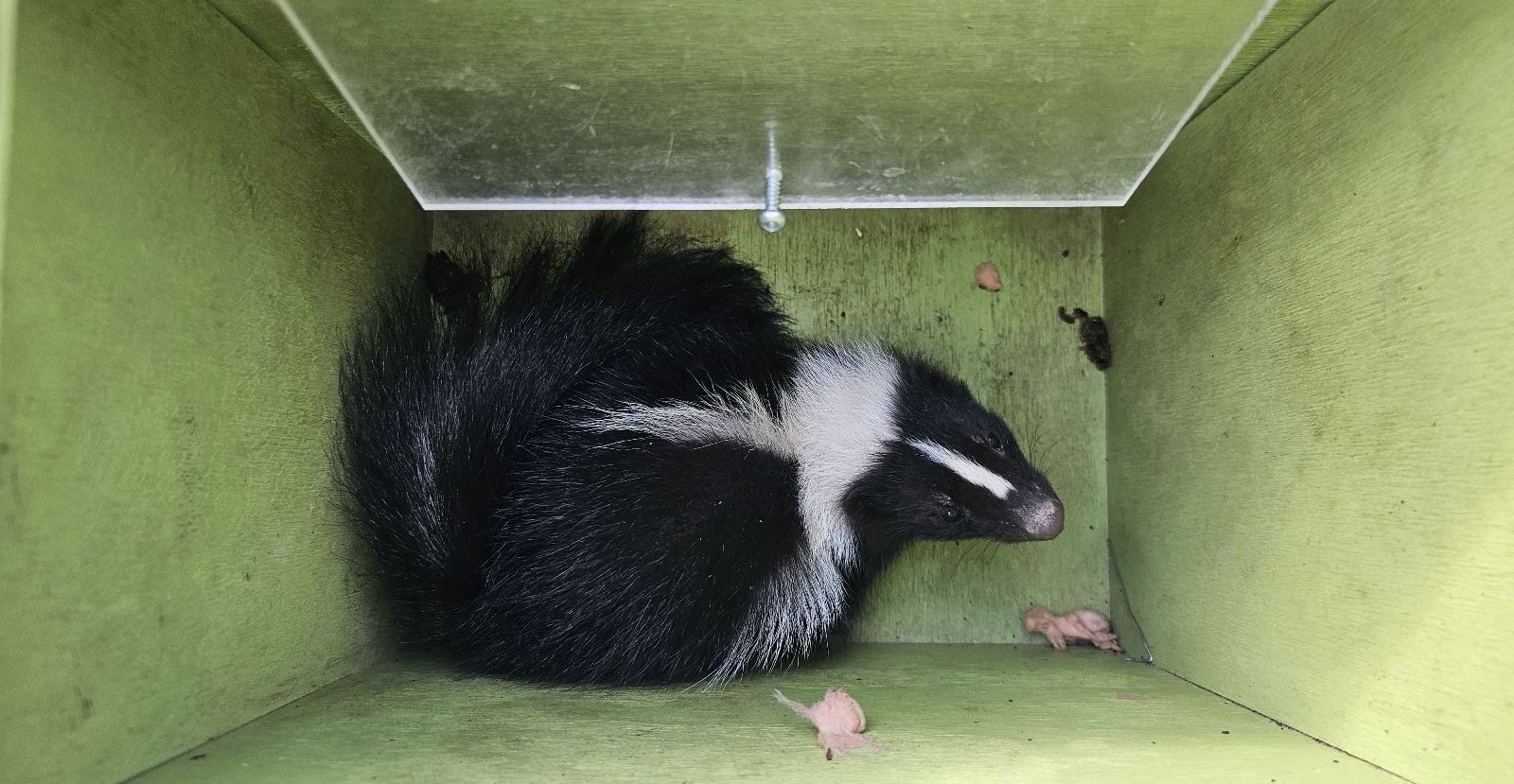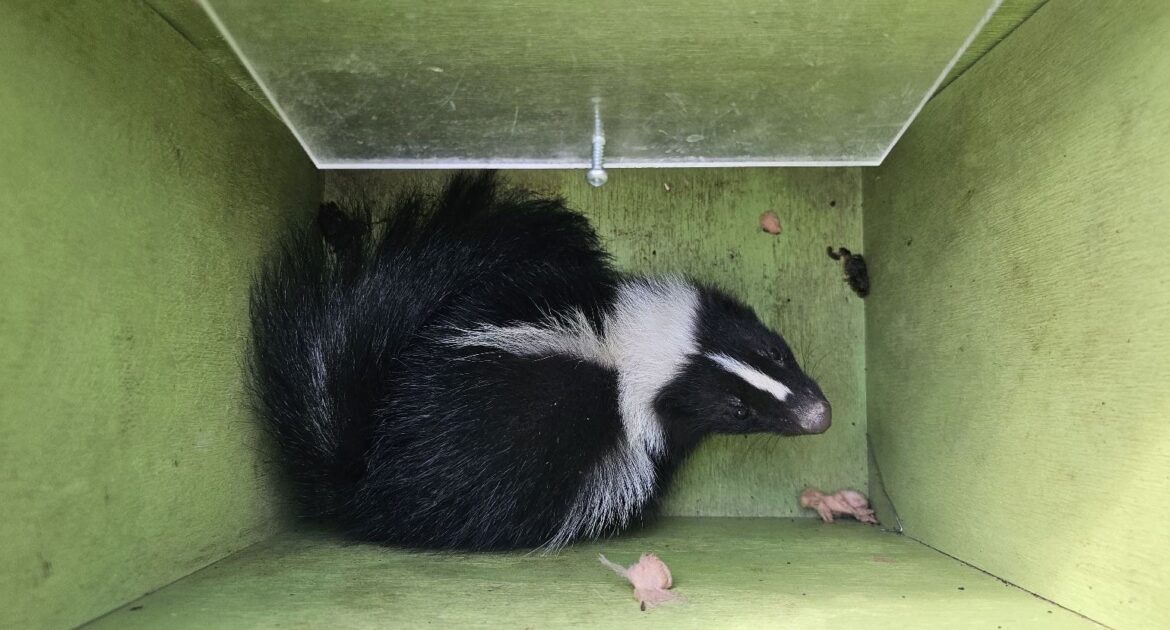You don’t expect to see a skunk when you open your back door, but it happens more often than people realize. Skunks in homes are becoming more common in Whitehall and across Ohio. These animals look slow and harmless, but when they find shelter near people, they bring strong odours, property damage, and even health risks.
So, what are the most common places skunks invade? The answer may surprise you. They aren’t only wandering through backyards; they know how to find weak points around homes. By learning about the most common skunk entry points, you’ll see why preventing skunk invasions is so important. At Skedaddle Humane Wildlife Control in Whitehall, we help families stay safe while respecting the animals.
This article will walk you through the top entry points skunks use, what problems they cause once inside, and how we step in to stop them.
Why Skunks Look for Homes
Before listing the common spots, it helps to know why skunks target houses in the first place. Like any animal, they’re looking for food, shelter, and safety. Cold winters in Whitehall make your home more attractive, especially when snow covers their natural food sources.
Key reasons include:
- Warmth: Heated homes and covered spaces protect them from freezing temperatures.
- Food Access: Garbage bins, pet food, and compost piles are easy meals.
- Protection: Basements, crawl spaces, and sheds give them cover from predators.
When these needs line up, skunks move closer—and sometimes right inside.
Common Skunk Entry Points
Here are the most common places skunks invade when searching for shelter. Each one shows how determined they are to live close to people.
Crawl Spaces
Crawl spaces are like a welcome mat for skunks in homes. The ground is soft, making it easy for them to dig under vents or weak foundations. Once inside, they create dens that are hard to reach.
This hidden space also traps odours, which can drift into the home. Skunks especially like crawl spaces because they stay warm in winter and cool in summer, offering year-round shelter. Since people rarely check these areas, skunks can live there unnoticed for long periods, making infestations worse before they’re discovered.
Decks and Porches
Decks are one of the most attractive spots for skunks. They’re dark, sheltered, and usually close to food sources like garbage or gardens. Families often notice digging around deck edges as the first sign of an invasion. Once they move in, removing them is tricky without our professional help. Here are a few things to keep in mind:
- Decks offer skunks a safe place to raise young, which can quickly multiply the problem.
- Odours from skunks under decks often spread inside the house.
- Because they’re so close to living areas, families usually notice the smell before spotting the animals.
Sheds and Outbuildings
Garden sheds are another favourite. Skunks squeeze through broken doors, loose panels, or gaps at the base. These spaces are warm and quiet, making them perfect for raising young in spring.
The damage to tools, equipment, and insulation can add up quickly. Skunks inside sheds may also dig burrows underneath, weakening the structure over time. Since sheds often store fertilizers, seeds, or pet food, the smells can attract skunks even more. A shed that seems harmless during the day may actually be hiding a family of wildlife.
Garages
A garage with a loose door seal is an open invitation. Skunks may slip in during the night, especially if food smells are nearby. Once inside, they can chew through bags, leave droppings, and spray if startled. A garage that feels “off” often points to hidden wildlife. Skunks also like garages because they are connected to the home, offering warmth and security. If left unchecked, they can damage wiring or insulation while exploring. Families may notice footprints or overturned bins before realizing they have a full invasion.
Basements
While less common, basements with foundation cracks or open vents can become skunk entry points. The warmth and safety of these spaces make them worth the effort. Problems grow quickly since basements connect directly to the rest of the house. Skunks here can cause strong odours that spread fast through air vents.
Because basements often store laundry, food, or furniture, droppings and digging can damage personal belongings. Once established, skunks may also create tunnels beneath the foundation, weakening the structure and causing expensive repair needs.
Attics
Most people don’t think of attics, but determined skunks sometimes reach them by climbing or following other weak spots. Attics provide insulation for nesting and quiet shelter. Droppings here cause strong odours and health risks that spread through vents. The insulation becomes ruined, and repairs can be costly once the animals leave. Skunks may also chew wires or scratch wood while exploring. Because attics are rarely visited, families might not know about the invasion until the smell becomes overwhelming or noise is heard at night.
Gardens and Compost Areas
While not technically “inside,” gardens and compost piles near homes attract skunks that later move closer. Easy access to food often leads to digging near decks, sheds, or crawl spaces. This is usually the first stage of a larger invasion. Here’s what you need to know:
- Skunks eat fruits, vegetables, and insects from the soil.
- Compost piles give off strong scents that act like an invitation.
- Once they find a steady food source, skunks often move closer to buildings for shelter.
Vents and Openings
Any open vent or loose grate is an easy doorway. Skunks squeezing into dryer vents or furnace openings is more common than people think. Once inside, they cause clogs and even fire hazards. These openings are also warm, making them extra appealing in colder months. If left unprotected, vents quickly turn into repeat entry points for wildlife. Families often notice strange smells from heating systems or hear scratching before realizing the true problem. Blocking vents properly is one of the most important steps in prevention.
Under Steps
Steps made of wood or concrete often have hollow spaces beneath them. Skunks love these spots because they are safe, close to the house, and rarely disturbed. Families usually find out when the smell becomes impossible to ignore. These areas are especially attractive in spring, when females are looking for safe dens for their babies. Since the space under steps is hard to access, skunks can live there for months before being noticed. Once established, they often dig tunnels that weaken the structure.
Trash Storage Areas
If garbage cans or recycling bins are kept against the house, skunks will hang around. The smell of food scraps draws them in, and nearby cracks or openings make it easy for them to explore further. Why is this important?
- Skunks knock over bins or chew through bags to reach food.
- Feeding near the house makes them more likely to nest close by.
- What starts as a simple food stop can quickly turn into a full invasion.
Preventing Skunk Invasions
Stopping problems before they start is the best solution. At Skedaddle, we focus on prevention to protect your home long-term. Here are a few common steps we recommend:
- Secure garbage bins so smells don’t attract animals.
- Seal weak spots like open vents, cracks, or loose boards.
- Maintain gardens and compost so they don’t become food sources.
- Check under decks and sheds for signs of digging before it gets worse.
By closing off these opportunities, you greatly reduce the chances of skunks making themselves at home.
Why Professional Help Matters
Skunks are shy, but they spray when threatened. Trying to block them or chase them away often makes the problem worse. At Skedaddle Humane Wildlife Control in Whitehall, we use safe and humane methods to deal with skunks in homes. Our team installs one-way doors that let animals leave but prevent them from coming back. We also secure entry points so your home stays protected.
This approach keeps families safe while respecting the role wildlife plays in the environment.
Keep Skunks Out the Safe Way
Skunks in homes are more than just a bad smell—they can harm property, affect health, and cause ongoing stress. The most common skunk entry points, like crawl spaces, sheds, and garages, make it easy for them to move in if left unprotected. Taking steps toward preventing skunk invasions early helps keep your home safe and saves you costly repairs later.
At Skedaddle Humane Wildlife Control in Whitehall, we use proven, humane methods to remove wildlife and stop it from coming back. Our team gives you long-term protection and peace of mind for your family. Request an estimate today to learn how we can help keep your home free of skunks.




